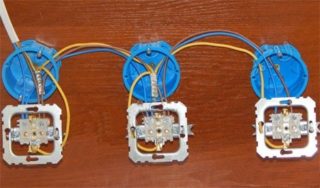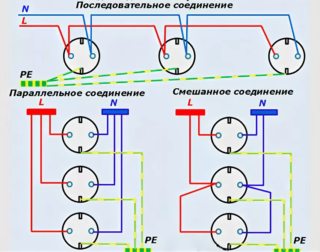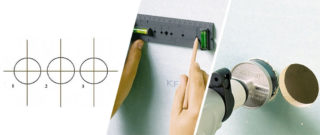No existing power supply system is complete without power outlets, in the absence of which normal functioning of household appliances is impossible. Due to the constant increase in the number of devices connected to them, the current load on the power line increases markedly. This cannot but affect the architecture of building household electrical networks, the total number of outlets in which it is necessary to increase. Users often have the need to connect 3 sockets from one wire without disturbing the distribution of currents in the supply line.
Types of electrical wiring
Before you figure out how to connect three outlets from one wire, it is advisable to familiarize yourself with the existing types of laying electrical circuits. In accordance with the rules for their arrangement, prescribed in the EMP, modern electrical wiring has two versions: closed and open. In the first case, the harness with wires, through which voltage is supplied, is laid hidden. For him, special recesses (gates) are made in the walls and ceiling in which the cable is laid. Benefits of Hidden Gasket:
- Reliable protection against mechanical damage.
- Safety of electrical wiring.
- The absence of external wires that degrade the aesthetics of rooms and other rooms.
The disadvantage is the difficulty of accessing the cable if it is necessary to restore it or completely replace it; repair will require a lot of labor.
 With the open method, laying is carried out on the surface of the walls and ceiling. The bundles in this case are placed in special boxes (cable channels) or in the corrugation. With their help, it is possible to hide the conductive veins, which remain, however, available for inspection and repair.
With the open method, laying is carried out on the surface of the walls and ceiling. The bundles in this case are placed in special boxes (cable channels) or in the corrugation. With their help, it is possible to hide the conductive veins, which remain, however, available for inspection and repair.
The advantages of this laying method:
- Easy maintenance and recovery.
- Availability when you need to connect an intermediate outlet.
- The possibility of arranging electrical wiring in the "retro" style.
The disadvantage of this technique is the need to divert special sections of walls for laying cable channels or corrugations, without making these zones furniture. To eliminate this inconvenience, the harnesses are laid in special niches available in plastic skirting boards.
When choosing the appropriate method for laying the bundle or cable, proceed from the specific conditions and requirements for connecting individual elements of the power supply network.
Connection Methods
Before you connect many power outlets in a row, it is important to understand the existing methods for connecting them. Depending on the switching order of the individual conductors, the following options are distinguished:
- Parallel connection, in which the sockets must be connected with a "star".
- Serial connection, otherwise called a "loop".
- Combined inclusion using a loop and a star.
- The connection in the ring.
Each of the listed methods is selected depending on the architecture of the room and considerations of saving on installation products. Parallel connection with a "star" is convenient when wiring the supply network from a single center (distribution board, for example).
The sequential method (or loop) is used when a number of outlets installed one after another are turned on on this line. Separate contacts (phase and zero) are connected to each other in parallel, the sequential method is called only because of the order of the location of the socket nodes.
When combined, in certain areas of the product, they are installed in a row, after which a “star” is arranged from one of them.
The “ring” connection is a sequential arrangement of sockets, the end of which closes at its beginning. This switching method allows you to connect sockets on large areas: at exhibitions, in workshops and trading floors.
Installation procedure
Before proceeding with the independent installation of outlets, you will need to read the instructions for their installation. The easiest way to consider an example is when they are installed in a drywall. The order of work in this case looks like this:
- An electric drill is taken with a nozzle of the “crown” type, by means of which a hole for a socket is prepared in a selected place. Its diameter should coincide with the size of the plastic case (cup) used as a mounting base and fixed directly at the installation site.
- A mounted socket is placed in the glass and fastened in it with the help of long expansion screws.
- It is necessary to connect the phase and neutral conductors brought out to the contacts, and then close the product with a decorative cover.
If there is a third core in the electrical wiring in the yellow-green insulation, its bare end is connected to the ground terminal on the outlet.
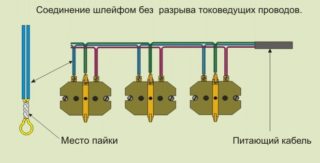 At the final stage of the work, you should supply power to the line and check the socket for operability - connect any household appliances to it.
At the final stage of the work, you should supply power to the line and check the socket for operability - connect any household appliances to it.
In order to correctly connect several outlets in a row (loop) at once, experts advise you to pay attention to the following points:
- The wire from the phase terminal of one socket unit extends to the same contact of the next product and so on. To such a loop, you can add the whole set of outlets installed in this room.
- The same applies to the neutral conductor laid from the corresponding contact to the second and subsequent products mounted on the wall.
- In the presence of a grounding conductor, the same operations are performed with it.
The advantages of this method of connection should include ease of implementation and economical use of consumables (wires). The disadvantages are the unreliability of the system in which a break in one of the conductors will lead to a blackout of all subsequent outlets connected to this cable. In this sense, star coupling is much preferable.
Installing the product with a switch
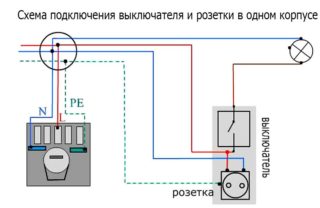 An interesting option from the point of view of connecting sockets is the version with a switch located in the same case. In this case, the connection operation is somewhat complicated, which is explained by the special switching circuit of the outlet. When connected to the loop, the phase wire is made through, it should not be connected to the return contact of the switch. If this outlet is turned off, the entire line of products following it will not be de-energized.
An interesting option from the point of view of connecting sockets is the version with a switch located in the same case. In this case, the connection operation is somewhat complicated, which is explained by the special switching circuit of the outlet. When connected to the loop, the phase wire is made through, it should not be connected to the return contact of the switch. If this outlet is turned off, the entire line of products following it will not be de-energized.
The advantages of combined designs include:
- Admissibility of exclusion of an electrical unit from a common loop without prejudice to all its other elements.
- Convenience of service and repair, not related to other outlet products.
- Aesthetics and ease of installation.
The only drawback of such devices from the point of view of the consumer is the high cost. Experts note the inconvenience of sockets combined with switches, which consists in the need to replace the entire product when one element fails.
